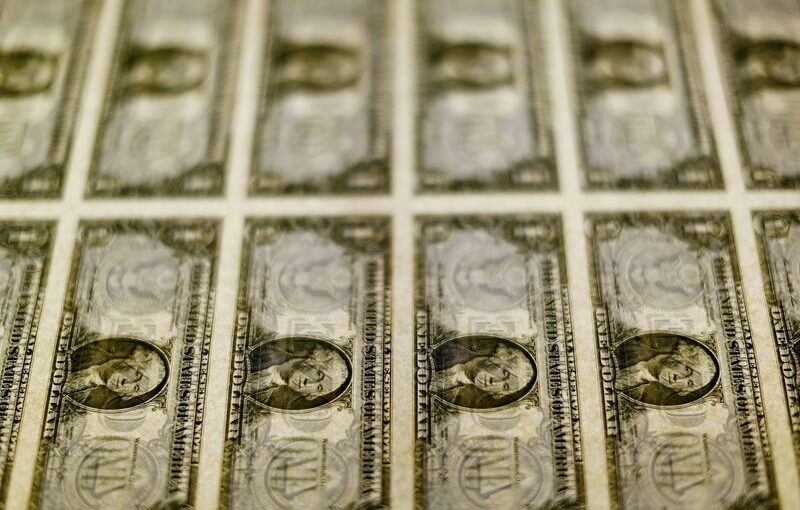LONDON (Reuters) – The dollar began the last quarter of 2021 near its highest levels of the year, and was headed for its best week since June as investors expected a hawkish-sounding Federal Reserve to lift U.S. interest rates sooner than its major peers.
Cautious market sentiment due to COVID-19 concerns, wobbles in China’s growth and a Washington gridlock ahead of a looming deadline to lift the U.S. government’s borrowing limit also lent support to the dollar which is seen as a safe-haven asset.
Refinitiv’s measure of the dollar index dipped to 94.166, having gained 1.1% so far this week, the largest weekly rise since late June.
Dollar index set for best week since June
“Last week’s Fed meeting added fresh life into the debate about a potential hike in the fed funds rate in 2022,” said Jane Foley, head of FX strategy at Rabobank.
“This is positive for the USD on two fronts. Firstly the USD looks better on a straightforward interest rate differential perspective. Secondly a hike in U.S. rates and a stronger USD will weigh on the growth outlook in EM.”
The growth outlook for emerging markets is already suffering on concerns of a slowdown in China and on fears of an energy crunch, Foley said.
“The result is that the USD benefits from a drop in risk appetite and flows out of higher risk EM markets.”
The euro was 0.1% higher on Friday at $1.1588, but has fallen about 1.3% during the week, and through major support around $1.16, to touch its lowest levels since July 2020.
The yen bounced from a 19-month low overnight but has lost 0.6% for the week and twice as much in a fortnight as a rise in U.S. Treasury yields has drawn flows from Japan into dollars. It last traded at 111.21 per dollar.
Benchmark 10-year Treasury yields are up for a sixth straight week and real 10-year yields US10YTIP=RR, discounted for inflation, are rising far more quickly than counterparts in Europe.
Commodity currencies made a bounce on the dollar on Thursday following a Bloomberg report that China had ordered energy companies to secure supplies for the winter at all costs, but were back under pressure on Friday. The offshore yuan hit a two-week high of 6.4420.
Beijing is scrambling to deliver more coal to utilities to restore supply amid a power crunch that has unsettled markets due to the likely hit to economic growth.
“The reasons to suspect an energy supply crunch in China are more deeply rooted and largely boil down to China’s new policy aimed at reducing greenhouse emissions, which have put increasing curbs on domestic coal output,” said Francesco Pesole, G10 FX strategist at ING.
“At the same time, a historic import route – the one with Australia – has recently come under pressure amid geopolitical and trade tensions between the two countries, which recently saw China impose duties on Australian coal.”
One way this is affecting the FX market is through the notion that the Chinese central bank is now welcoming a stronger yuan in an attempt to insulate the country against soaring commodity prices, Pesole said.
“It appears that markets have increasingly sunk their teeth into this narrative, and CNY’s resilience to the Evergrande saga looks like a testament to this.”
The Australian dollar gained 0.3% to $0.7242 and slumped 3.6% in the third quarter – the worst performance of any G10 currency against the dollar – as prices for Australia’s top export, iron ore, fell sharply. The New Zealand dollar gained 0.2% to $0.6911.
Central banks in both countries meet next week, with the Reserve Bank of New Zealand seen hiking while the Reserve Bank of Australia is expected to stick with its forecast to keep rates where they are until 2024.
Sterling was also an underperformer last quarter, dropping 2.5%, and looks set to log its worst week in more than a month, weighed down by worries about a hawkish sounding central bank in spite of growing supply chain problems.
Sterling gained 0.3% to trade just above a 9-month low at $1.3516.
Markets in Hong Kong and China were closed on Friday. Traders are awaiting U.S. personal spending and core consumption deflator data later in the day and nervously watching for any progress on the debate over raising the U.S. debt ceiling.
A deadline for authorising extra Treasury borrowing looms in mid-October.
Source: Read Full Article
